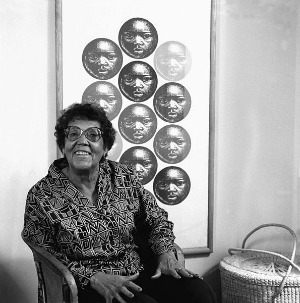Elizabeth Catlett: An Appreciation
The impact of her sculpture Target extends to the thousands of anonymous people of color, mostly but not exclusively younger males, who are routinely subjected to racist harassment and attacks by police and others throughout the United States.Dignified portrayals of African-Americans, especially of women, were a major feature of her sculpture and prints.
On March 31, I gave my final tour of the exhibition “Places of Validation” that I co-curated at the California African American Museum in Los Angeles. When I came to the sole work in the show by Elizabeth Catlett, a sculpture entitled El Abrazo (The Embrace), I remarked to the audience that this gorgeous work, carved from a single piece of mahogany in 1976, was typical of Catlett’s graceful figurative style, which she perfected throughout seven decades of a magnificent career. I also noted that many critics and art historians regarded Catlett as one of America’s finest contemporary visual artists and an exemplar of a socially engaged one. This is a judgment that I have regularly expressed in both my teaching and writing for well over 30 years.
Only two days later, I received word of her death in Cuernavaca, Mexico, at the age of 96, just a few weeks short of her 97th birthday. Mexico, the United States and the entire world lost one of the leading black, feminist and political artists of the 20th and early 21st centuries. That truly remarkable woman devoted her life to expressing critical ideas in powerful visual form both in the United States and in her adopted country of Mexico. Her majestic career as an artist, educator and activist deserves appreciation and honor.
Her creative journey began at Howard University, where she studied under African-American artistic legends James Porter, James Lesesne Wells and Lois Mailou Jones. After graduating in 1937, she completed her MFA in 1940 at the university, studying with another iconic American artist, Grant Wood, who encouraged her to work on themes she knew and personally experienced. For the rest of her career, accordingly, she produced prints and sculptures that addressed the plight of the poor and impoverished, the horrors of racism and colonialism, the dignity of ordinary people of color and numerous other socially conscious themes that made her the heir of artistic giants Francisco Goya, Kathe Kollwitz, Ben Shahn and hundreds of others.
In 1941, she married another politically inspired artist, Charles White. Visiting Mexico, they found the mural and printmaking tradition there artistically and politically engaging. After the marriage ended, she moved to Mexico in the wake of postwar American political repression that eviscerated the Constitution and caused the infamous blacklists of thousands in the arts, entertainment, education and other fields for more than 20 years.
In Mexico City, Catlett met and married Mexican artist Francisco Mora and worked at the Popular Graphics Workshop (Taller de Grafica Popular). There, she and her colleagues produced inexpensive prints that had powerful social and political content that would appeal to working-class Mexicans. A strong selection of her popular prints from that era went on exhibit at the Mexican Cultural Institute in Washington, D.C., in 2010. I had the privilege of conducting a tour of that exhibition when I taught at the University of California, Washington Center that spring term.
Catlett became a Mexican citizen in 1962 and taught at the School of Fine Arts in the National Autonomous University in Mexico City from 1958 to 1976. Throughout her residence in Mexico, she also spent several months each year in New York — except for during the 1960s, when she was declared an “undesirable alien” and denied a visa because of her leftist political views and activities. In Mexico, she is proudly regarded as a national treasure and her works are prominently displayed in cultural institutions including the Museum of Modern Art in Mexico City.
Dignified portrayals of African-Americans, especially of women, were a major feature of her sculpture and prints. Her compelling portraits of anonymous black working women complemented her portraits of historical luminaries such as Sojourner Truth, Phillis Wheatley, Harriet Tubman and Angela Davis. Her treatment of African-American mothers and children added a welcome dimension to a universal artistic theme. Other works honoring children of color augmented her stature as a major humanist artist of the contemporary era. Her public sculptures, like her majestic depictions of Louis Armstrong and Mahalia Jackson in New Orleans, also contributed to her stellar international reputation.
Specific political commentary also pervaded her artwork over the years. Above all, she provided striking visual support for the historic African-American struggles for freedom and dignity. Her prints “Civil Rights Congress” (1949), “Malcolm Speaks for Us” (1969) and several others join sculptures including Homage to My Young Black Sisters (1968) and Black Unity (1968) to reveal her enduring commitment to the tradition of militant black protest, one of the major themes of African-American visual art for more than 100 years. In more recent decades, Catlett created prints that revealed the continuing plight of black children in a racist environment in America that persisted despite the advances of the modern civil rights movement.
As a naturalized Mexican, she used her art to offer critical commentary about Latin American politics. Such 1980s linocuts as “Chile I” and “Chile II” called dramatic attention to the horrific human rights violations of the Pinochet military dictatorship in Chile after the U.S.-aided overthrow of the lawful government there in 1973. “Central America Says No” (1986) similarly condemns American support of oppressive military regimes there during the Reagan administration. Cumulatively, Catlett’s artworks established an exemplary model of combining excellent technique and trenchant social commentary.
Only two days after her death, I decided to pay tribute to her life and work in my Race, Racism and American Law course at UCLA. I reproduced and distributed her 1970 sculptural work called Target. This provocative work shows a black male behind a gun sight, a powerful reminder of an ugly racist reality in both historical and contemporary America. I asked the upper division and graduate students in this class to reflect on the deeper significance of Catlett’s work.
The timing was disconcertingly appropriate for discussing Target. The nation has been focused on the tragic slaying of Trayvon Martin, a killing with obvious racial overtones. Moreover, Catlett’s brilliant three-dimensional artwork also reminds viewers about such recent cases as those of Rodney King, Abner Louima, Amadou Diallo, Oscar Grant and professor Henry Louis Gates — all instances of targeted black men that occurred after she produced her chilling piece. The impact of Target, however, extends even further to the thousands of anonymous people of color, mostly but not exclusively younger males, who are routinely subjected to racist harassment and attacks by police and others throughout the United States.
When students and other viewers of Elizabeth Catlett’s artworks reflect on their powerful social meaning and implications, it ensures that her legacy will endure for generations to come. The profound educational impact of her art, combined with its remarkable aesthetic qualities, solidifies her reputation as an authentic giant of modern art history. And her consummate commitment to use her art to serve people of all races and classes will be the model for all socially engaged artists for the remainder of the 21st century and beyond.
Your support matters…Independent journalism is under threat and overshadowed by heavily funded mainstream media.
You can help level the playing field. Become a member.
Your tax-deductible contribution keeps us digging beneath the headlines to give you thought-provoking, investigative reporting and analysis that unearths what's really happening- without compromise.
Give today to support our courageous, independent journalists.






You need to be a supporter to comment.
There are currently no responses to this article.
Be the first to respond.